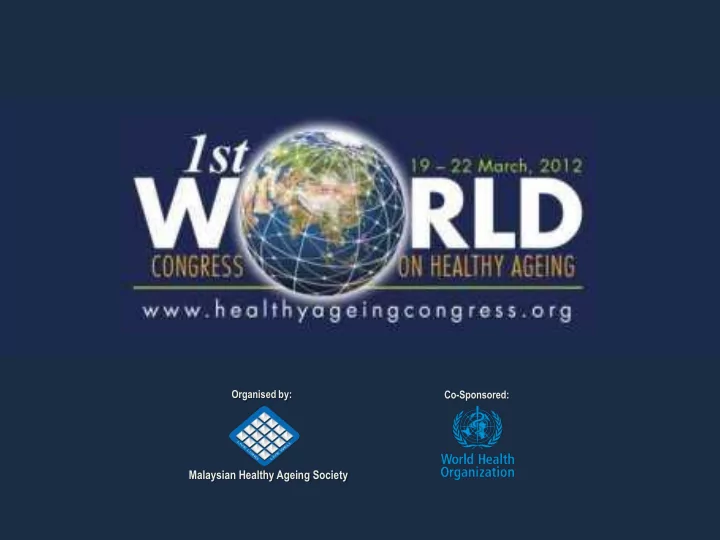

Organised by: Co-Sponsored: Malaysian Healthy Ageing Society
Problem Drinking and Associated Factors in Older Adults in South Africa Karl Peltzer and Nancy Phaswana-Mafuya (HIV/AIDS/SIT & TB (HAST) Research programmes)
Background Alcohol abuse poses special risks for increased morbidity and mortality among older adults. Little attention has focused on assessing alcohol use and associated factors among older adults in transitional societies such as South Africa
Sample • We conducted a national population- based cross-sectional study with a sample of 3840 aged 50 years or older in South Africa in 2008. • In this study we analysed data from all 2144 participants who were over 60 years old. • The SAGE sample design entails a two- stage probability sample that yields national and sub-national estimates
Measures-1 Alcohol use frequency and average consumption was assessed; first “In the last 12 months, how frequently [on how many days] on average have you had at least one alcoholic drink?” Response options included 1=less than once a month to 4=five or more days a week; second “In the last 12 months, on the days you drank alcoholic beverages, how many drinks did you have on average? Response option is the number of drinks. Risky drinking was defined in two ways: heavy drinkers (>7 drinks/week) and as binge drinkers (>3 drinks/one occasion/week). These are considered Risky Drinking according to the National Institute on Alcohol Abuse and Alcoholism (NIAAA). Exceeding these limits is associated with interpersonal and functioning problems for elders
Measures 2 Anthropometry . Height, weight, waist and hip circumferences Physical activity was measured using the General Physical Activity Questionnaire (GPAQ). Overall self-rated health status Activity limitation (difficulty an individual may have in executing task or actions) was assessed with one item “Overall in the last 30 days, how much difficulty did you have with work or household activities?” Symptom-based depression in the past 12 months was assessed based on the World Mental Health Survey version of the Composite International Diagnostic Interview
Sample characteristics Socio-demographic N=2144 % Gender Male 881 42.2 Female 1263 57.8 Age (years) 60-69 1233 61.1 70 and over 911 38.9 Population group African Black 1134 70.7 White 170 11.6 Coloured 375 13.1 Indian or Asian 165 4.5 Marital status Single 212 10.2 Married 1014 52.1 Separated/Divorced 101 4.7 Widow 779 33.0 Education level Less than primary 1119 51.2 Primary 492 22.5 Secondary 415 21.5 More than secondary 86 4.8 Geolocality Rural 749 36.8 Urban 1392 63.2 Alcohol use Ever used alcohol 548 23.7 Alcohol use in past month 292 10.7 Risky drinking Heavy drinker 106 4.0 Binge drinker 97 3.7 Co-morbidity Hypertension 700 36.7 Diabetes 237 11.3 Depression 68 3.7 Tobacco use 435 18.6 Obesity 839 45.8
Associations-1 Heavy drinker Binge drinker UOR (95% CI) AOR (%% CI) UOR (95% CI) AOR (%% CI) Gender Female 1.00 1.00 1.00 1.00 Male 3.80 (1.64- 3.55 (1.05- 3.53 (1.52-8.20)** 3.79 (1.38-10.37)* 8.83)** 12.02)* Age 60-69 1.00 1.00 1.00 1.00 70 and over 0.66 (0.36-1.23) 0.59 (0.30-1.16) 0.48 (0.22-1.05) 0.41 (0.16-1.04) Population group African Black 1.00 1.00 1.00 1.00 White 1.55 (0.54-4.44) 1.95 (0.75-5.10) 2.10 (0.84-5.28)* 3.01 (1.31-6.89)* Coloured 0.63 (0.18-2.15) 0.49 (0.17-1.46) 0.53 (0.20-1.46) 0.48 (0.20-1.18) Indian or Asian 0.47 (0.12-1.93) 0.40 (0.06-2.85) 0.52 (0.13-2.14) 0.51 (0.08-3.30)
Associations-2 Heavy drinker Binge drinker UOR (95% CI) AOR (%% CI) UOR (95% CI) AOR (%% CI) Marital status Single 1.00 1.00 1.00 --- Married 2.59 (1.33-5.04)** 1.84 (0.70-4.88) 1.63 (0.74-3.55) Separated/Divorced 1.39 (0.35-5.55) 0.87 (0.14-5.46) 1.90 (0.46-7.90) Widow 1.12 (0.53-2.37) 1.05 (0.47-2.34) 0.83 (0.33-2.10) Educational level Less than primary 1.00 1.00 1.00 1.00 Primary 0.92 (0.48-1.79) 1.00 (0.49-2.05) 0.77 (0.39-1.51) 0.82 (0.43-1.57) Secondary 0.80 (0.33-1.98) 1.44 (0.41-5.00) 1.06 (0.46-2.46) 1.26 (0.45-3.49) Wealth Low 1.00 1.00 1.00 1.00 Medium 0.66 (0.37-1.17) 0.62 (0.32-1.18) 0.59 (0.32-1.09) 0.54 (0.27-1.09) High 0.75 (0.27-2.11) 0.61 (0.23-1.18) 0.86 (0.33-2.26) 0.70 (0.28-1.73) Geolocality Rural 1.00 --- 1.00 --- Urban 1.14 (0.57-2.31) 1.32 (0.64-2.70)
Associations-3 Heavy drinker Binge drinker UOR (95% CI) AOR (%% CI) UOR (95% CI) AOR (%% CI) Co-morbidity Hypertension 0.72 (0.30-1.71) --- 0.92 (0.41-2.08) --- Diabetes 0.12 (0.03-0.45)** 0.28 (0.06-1.27) 0.40 (0.13-1.24) --- Depression 1.11 (0.48-2.59) --- 0.88 (0.29-2.66) --- Tobacco use 7.27 (3.09-17.12)*** 6.35 (2.47-16.33)*** 5.26 (2.31-11.96)*** 5.25 (2.20-12.52)*** Obesity 0.12 (0.06-0.23)*** 0.13 (0.05-0.32)*** 0.12 (0.06-0.27)*** 0.14 (0.05-0.35)*** Subjective health 1.03 90.49-2.14) 0.94 (0.44-2.01) status (bad/very bad) Activity limitation 0.96 (0.62-1.50) 0.90 (0.59-1.39) (Low, Moderate, High) Physical activity High 1.00 1.00 Moderate 0.67 (0.30-1.47) 0.48 (0.19-1.25) Low 0.65 (0.31-1.38) 0.59 (0.26-1.36) Both heavy and binge drinking were adjusted mutually by gender, age, educational level, wealth and depression
Discussion-1 The study found that there was a decrease of alcohol use with age but this was not significant, as found in some other studies. This would indicate that daily drinking would pose an increasing problem as with aging and would require specific attention.
Discussion-2 In concordance with other studies this study found an association between tobacco use and hazardous or harmful drinking. Public health interventions should address multiple substance use risk behaviour. The finding that obesity was protective of risky drinking in both older women and men is less clear
Conclusion This study reveals moderate rates of risky drinking among older adults (60 years and more) in South Africa that puts them at risk of morbidity. Alcohol problems among older adults are commonly under-recognized needing health care worker intervention.
Acknowledgments • Funding was provided predominantly from the National Department of Health with additional funding provided by United States National Institute on Aging, WHO and the Human Sciences Research Council. Technical assistance was provided by the WHO, Geneva.
Recommend
More recommend